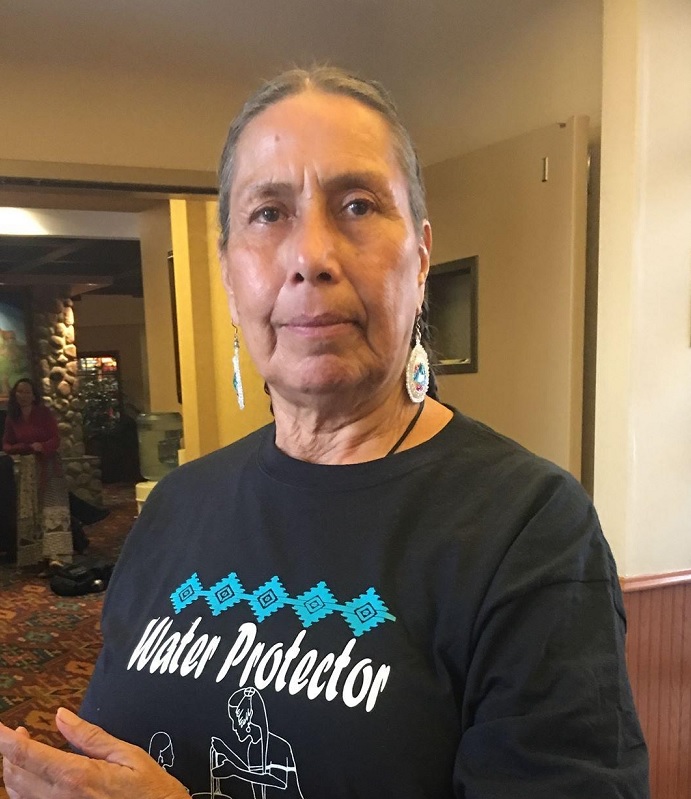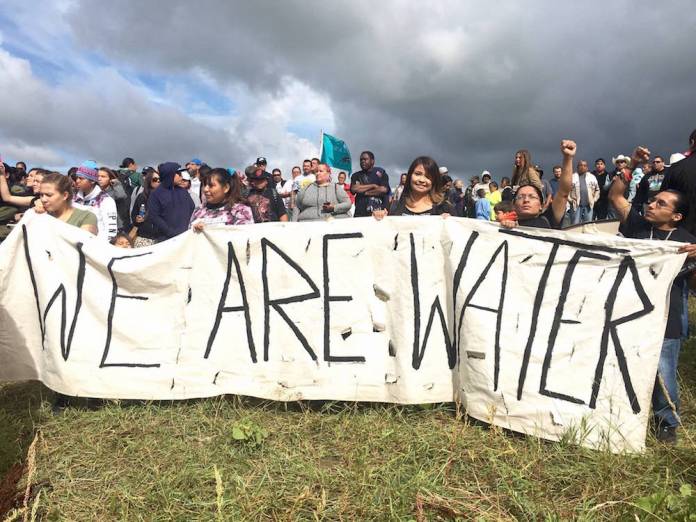Rose Aguilar is sending daily reports from the pipeline protests at Standing Rock. Read more coverage here.
It’s Friday night. I’m flying back to Bismark, North Dakota for my second trip to the Oceti Sakowin Camp near the Standing Rock Sioux reservation in North Dakota.
Earlier today, independent journalists Mark Trahant and Jihan Hafiz joined my radio show Your Call on KALW in San Francisco to discuss media coverage of the militarized police raid and yesterday’s arrests of more than 100 Native American water protectors and their non-Native allies who are resisting the $3.8 billion Dakota Access oil pipeline. Watch events unfold in this disturbing video from Unicorn Riot.
Trahant, a member of the Shoshone-Bannock Tribes who has written about American Indian and Alaska Native issues for more than three decades, expressed a clear sense of frustration with the lack of coverage in the national media and the violent police response.
In his latest piece, he writes, “Every preposterous and painful image from North Dakota is another reminder of injustice: The massive police, military-style occupation of Standing Rock Treaty lands, the rush to protect the frantic construction schedule for the Dakota Access Pipeline, and the brutal law enforcement march against people who are fighting for the simple idea that water is life. I’m angry. How shall I say this without ranting? Tell stories.”
Thanks to Facebook Live, Native Americans like Indigenous Environmental Network organizer Dallas Goldtooth and writer Sarah Sunshine Manning are telling their own stories from or near the front lines in real time. “The story that’s being told by official sources is just wrong,” Trahant told me. “People can see for themselves that there’s another version of the truth that’s more accurate.”

The Camp of the Sacred Stones reports that more than 300 police officers in riot gear from five states arrived just north of the newly formed frontline camp yesterday with eight ATVs, five armored vehicles, two helicopters, and a number of military–grade humvees. They were armed with batons, tasers, mace, pepper spray, rubber bullets, percussion grenades, a sound cannon, and other so-called less-lethal ammunition.
After a more than six-hour standoff, water protectors took to social media to share what they endured.
“I went to the frontline in prayer for protection of the Missouri River and found myself in what I can only describe as a war zone,” writes Kandi Mossett, organizer with the Indigenous Environmental Network. “I was sprayed in the face with pepper spray. The guy next to me was shot by something that didn’t break the skin, but appeared to have broken the ribs and another guy beside me was randomly snatched violently. I’m still in shock and keep waiting to wake from what’s surely a nightmare, though this is my reality as a Native woman in 2016 trying to defend the sacred.”
Eryn Wise of the International Indigenous Youth Council writes, “Today more than half of our youth council were attacked, injured or arrested. I have no words for what happened to any of us today. They are trying to again rewrite our narrative and we simply will not allow it. Our youth are watching and remember the faces of the officers that assaulted them. They pray for them.”
When people were released from jail yesterday, they told journalist Sandy Tolan that police wrote numbers on their arms during the booking process and they were kept overnight in dog kennels without bedding.
“It goes back to concentration camp days,” said Mekasi Camp-Horinek in an interview with Tolan. Camp-Horinek said he spent the night in an enclosure with his mother Casey.
Thanks to Democracy Now’s reporting, we recently learned that after being arrested, many Native Americans, including Standing Rock Sioux Chairman Dave Archambault, have been strip searched and forced to cough and squat.
Journalist Jihan Hafiz reports that when she was arrested on October 22, a number of Native women were forced to spread their body parts and jump up and down while coughing.
“We were refused phone calls and received no food or water for eight hours after being arrested,” she writes. “Two women fainted from low blood sugar and another had her medication taken away, causing her to shake and sweat profusely.”
This raises a few important questions. Why are people being strip searched? Who’s making these decisions? I have yet to receive a call back after leaving multiple messages with the offices of Morton County Sherriff Kyle Kirchmeier and North Dakota Governor Jack Dalrymple. Hafiz and other journalists are also trying to find answers to these questions.
Trahant says this kind of humiliation against the Native community is par for the course in North Dakota, but the strip searches are bringing it to the surface in a “very ugly way.”
Amnesty International USA (AIUSA) has sent a delegation of human rights observers back to Standing Rock to monitor the response of law enforcement.
“Our observers are here to ensure that everyone’s human rights are protected,” said Eric Ferrero, director of communications for AIUSA. “We’re deeply concerned about what we heard during our previous visit to Standing Rock and what has been reported to us since.”
AIUSA has also sent a letter to the Morton County Sherriff’s Department expressing concerns and is planning to ask the Department of Justice to investigate police practices, including strip searches and the use of attack dogs, which Democracy Now! broadcast to the world over Labor Day weekend.
Despite the arrests and violent crackdowns, water protectors say they plan to stay for as long as it takes to stop the pipeline, even if that means resisting in freezing temperatures.
Near the end of my radio show, I asked Mark Trahant to answer a question he recently posed in Yes Magazine. How far will the authorities in North Dakota go to get the pipeline?
“I think they’re willing to kill people,” he said. “Yes, they’re willing to arrest people, but more than that, they’re willing to use lethal force because this pipeline is that important to them. The irony is that it’s not needed. The oil can get to markets anyway. [This pipeline] is just a way to do it faster and increase profits.”
“It’s a miracle that no one was killed yesterday,” added Hafiz. “The way that they were shooting at people with non lethal weapons. I’ve seen people die in Egypt that way. It’s very shocking that no one was killed.”
Rose Aguilar is the host of Your Call, a daily call-in show on KALW 91.7 FM in San Francisco. Over the next few days, she’ll be filing daily reports from Standing Rock.






